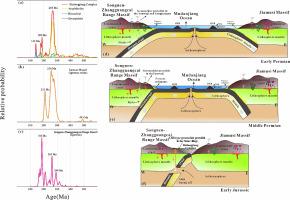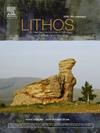Late Paleozoic–Early Mesozoic subduction history of Mudanjiang Ocean: New insights from greenschist in the Heilongjiang Complex, NE China
IF 2.9
2区 地球科学
Q2 GEOCHEMISTRY & GEOPHYSICS
引用次数: 0
Abstract
This paper presents zircon U-Pb ages, whole-rock major and trace element data, and Sr-Nd-Hf isotopic compositions for the greenschists from the Heilongjiang Complex in NE China. Based on the geochronological and geochemical characteristics, the greenschists from the Heilongjiang Complex can be categorized into three series: Early Permian tholeiitic series (275 ± 1 Ma and 273 ± 1 Ma), Middle Permian alkaline series (261 ± 1 Ma), and Early Jurassic alkaline series (179 ± 1 Ma). The Early Permian tholeiitic greenschist samples are characterized by remarkable negative Nb and Ta anomalies, and they exhibit relatively low whole-rock (87Sr/86Sr)i values (0.703896–0.704252), along with positive εNd(t) values (+7.66 to +8.65) and positive εHf(t) values (+0.92 to +11.51), implying that their protoliths originated from the partial melting of a depleted mantle wedge that has been metasomatized by subducted slab fluids. The Middle Permian alkaline greenschist samples have high Nb (17.3–19.0 ppm), TiO2 (1.40–1.64 wt%), and P2O5 (0.60–0.68 wt%) concentrations, and they are enriched in large ion lithophile elements and light rare earth elements, and depleted in high field strength elements and heavy rare earth elements, with high whole-rock (87Sr/86Sr)i values (0.709434–0.709949), negative εNd(t) values (−4.73 to −4.72) and varied εHf(t) values (−10.11 to +4.86), which compositionally align with those of Nb-enriched basalts. Based on the geochronological and geochemical characteristics, we propose that the protolith generation of Middle Permian alkaline greenschists was associated with the partial melting of a mantle wedge that had been metasomatized by subduction slab-derived melts. The Early Jurassic alkaline greenschist samples display OIB affinities, characterized by whole-rock (87Sr/86Sr)i values ranging from 0.705161 to 0.705926, εNd(t) values between +6.16 and +6.19, and εHf(t) values from +3.44 to +9.32, indicating the formation of the protolith for the Early Jurassic alkaline greenschist was related to the upwelling of the asthenosphere resulting from slab break-off. By integrating regional geological data, we can trace the subduction evolution of the Mudanjiang Ocean back to the Early Permian, and the slab break-off during the Early Jurassic likely corresponded to the early stage of the closure of the Mudanjiang Ocean.

牡丹江洋晚古生代-中生代早期的俯冲史:从中国东北黑龙江复合体绿泥石中获得的新启示
本文介绍了中国东北黑龙江群绿泥石的锆石U-Pb年龄、全岩主要元素和微量元素数据以及Sr-Nd-Hf同位素组成。根据地质年代和地球化学特征,黑龙江岩群的绿泥石可分为三个系列:早二叠世托勒密系列(275±1 Ma 和 273±1 Ma)、中二叠世碱性系列(261±1 Ma)和早侏罗世碱性系列(179±1 Ma)。早二叠世托勒密绿泥石样本具有显著的负 Nb 和 Ta 异常,全岩 (87Sr/86Sr)i 值相对较低 (0.703896-0.704252),εNd(t) 值为正 (+7. 66 至 +8.65),εNd(t) 值为负 (+8. 66 至 +8.65)。66至+8.65)和正εHf(t)值(+0.92至+11.51),这意味着它们的原岩起源于被俯冲板块流体变质的贫化地幔楔的部分熔融。中二叠统碱性绿泥石样品具有较高的 Nb(17.3-19.0 ppm)、TiO2(1.40-1.64 wt%)和 P2O5(0.60-0.68 wt%)浓度,富含大离子亲岩元素和轻稀土元素,贫乏高场强元素和重稀土元素,具有较高的全岩(87Sr/86Sr)i 值(0.709434-0.709949)、负εNd(t)值(-4.73至-4.72)和变化的εHf(t)值(-10.11至+4.86),在成分上与富铌玄武岩一致。根据这些地质年代和地球化学特征,我们认为中二叠统碱性绿泥石的原岩生成与地幔楔的部分熔融有关,而地幔楔是由俯冲板源熔体变质而成的。早侏罗世碱性绿泥石样品具有OIB亲缘特征,其全岩(87Sr/86Sr)i值介于0.705161至0.705926之间,εNd(t)值介于+6.16至+6.19之间,εHf(t)值介于+3.44至+9.32之间,表明早侏罗世碱性绿泥石原岩的形成与板块断裂导致的星体层上涌有关。通过整合区域地质资料,我们可以将牡丹江洋的俯冲演化追溯到早二叠世,而早侏罗世的板块断裂很可能对应于牡丹江洋闭合的早期阶段。
本文章由计算机程序翻译,如有差异,请以英文原文为准。
求助全文
约1分钟内获得全文
求助全文
来源期刊

Lithos
地学-地球化学与地球物理
CiteScore
6.80
自引率
11.40%
发文量
286
审稿时长
3.5 months
期刊介绍:
Lithos publishes original research papers on the petrology, geochemistry and petrogenesis of igneous and metamorphic rocks. Papers on mineralogy/mineral physics related to petrology and petrogenetic problems are also welcomed.
 求助内容:
求助内容: 应助结果提醒方式:
应助结果提醒方式:


